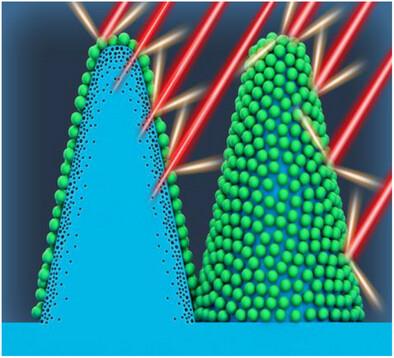超快激光诱导表面分层结构及纳米缺陷工程的超宽带平面黑体
IF 26.8
1区 材料科学
Q1 CHEMISTRY, MULTIDISCIPLINARY
引用次数: 0
摘要
根据普朗克定律,黑体是理想的吸光物体,在地球上是不存在的。然而,它们在天文学、光电子学和热辐射工程领域的应用具有重要意义。虽然腔体、平面黑体等人造黑体在一定程度上接近理想黑体,但存在体积大、发射率低、带宽窄、均匀性差、附着力弱等问题。本文报道了一种依靠超快激光直接照射的方法,该方法可以在3-14µm的超宽带光谱范围内,在掺杂硅表面上快速写入高发射率超过0.98的均匀平面黑体。在激光材料中发现了能量负反馈调节现象,这使得分层表面结构和纳米缺陷诱导的能级工程可以同时实现。由此产生的微纳分层锥阵列结构有效地抑制了光的后向散射,并增强了纳米缺陷诱导的吸收。由于激光处理的表面不需要材料粘附或注射,与传统的黑色涂层相比,它表现出优越的稳定性。超过900°C的高温测试和反复的机械剥落测试证实了这一点,强调了其在恶劣环境条件下的弹性。本文章由计算机程序翻译,如有差异,请以英文原文为准。

Ultra-Broadband Plane Blackbody by Ultrafast Laser Induced Surface Hierarchical Structuring and Nanodefect Engineering
Blackbodies, ideal light-absorbing objects per Planck's law, do not occur in nature on Earth. Nevertheless, they are of utmost significance in applications across astronomy, optoelectronics, and thermal radiation engineering. While artificial counterparts such as cavity blackbodies and plane blackbodies can approximate ideal blackbodies to some extent, they are beset with problems, including large volume, low emissivity, narrow bandwidth, poor uniformity, and feeble adhesion. Here, a method relying on ultrafast laser direct irradiation is reported, which enables fast writing of uniform plane blackbodies with high-emissivity over 0.98 in an ultra-broadband spectrum of 3–14 µm on a doped silicon surface. A phenomenon of energy negative feedback regulation in laser-material is discovered, which allows for the simultaneous implementation of hierarchical surface structuring and nanodefect-induced energy-level engineering. The resulting micro-nano hierarchical cone-array structure effectively curbs light back-scattering and intensifies nanodefect-induced absorption. Since the laser-treated surface does not entail material adhesion or injection, it exhibits superior stability in contrast to traditional black coatings. This is corroborated by high-temperature tests exceeding 900 °C and repeated mechanical exfoliation tests, underscoring its resilience in harsh environmental conditions.
求助全文
通过发布文献求助,成功后即可免费获取论文全文。
去求助
来源期刊

Advanced Materials
工程技术-材料科学:综合
CiteScore
43.00
自引率
4.10%
发文量
2182
审稿时长
2 months
期刊介绍:
Advanced Materials, one of the world's most prestigious journals and the foundation of the Advanced portfolio, is the home of choice for best-in-class materials science for more than 30 years. Following this fast-growing and interdisciplinary field, we are considering and publishing the most important discoveries on any and all materials from materials scientists, chemists, physicists, engineers as well as health and life scientists and bringing you the latest results and trends in modern materials-related research every week.
 求助内容:
求助内容: 应助结果提醒方式:
应助结果提醒方式:


